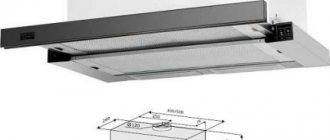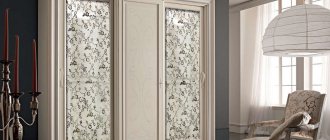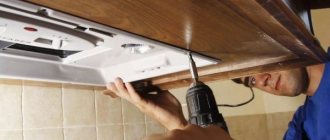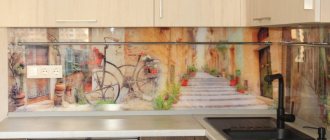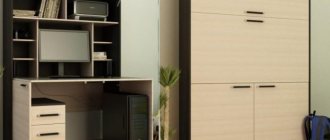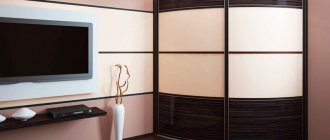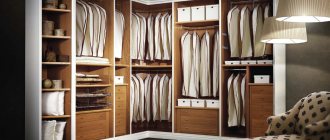Today, kitchen interiors are equipped with many useful things, among which household appliances play an important role. Modern headsets have the ability to integrate devices, making the room not only functional, but also aesthetically attractive. Among the most popular built-in household appliances is a fume hood. This design has many advantages, but the main ones are space saving and a unified harmonious appearance of the kitchen. Fume hoods were created to hide unattractive ventilation and hood communications. Their meaning is mainly decorative, but in order for the space inside to also fulfill its function, you can equip them with shelves for storing dishes or bulk products. The design of the cabinet matches the set as a whole and externally it is indistinguishable from other modules.
Advantages of built-in hoods
The hood in the kitchen should be located directly above the hob, so the hood will do its job more efficiently - purify or remove contaminated air during cooking. The main advantage of this design is its invisibility, unlike island or classic type hoods. Almost the entire body of the hood is hidden in the wall cabinet; only the lower working part is visible, through which the air enters the ventilation duct or is cleaned using a carbon filter.
Some interiors, due to the small space, cannot accommodate a classic hood, then a device built into the cabinet will be an ideal option. It takes up very little space inside the furniture and allows you to additionally use the space for storing small kitchen utensils. Some fume hoods can be equipped with built-in lighting in the form of incandescent lamps, which ensure comfortable use of the hob at any time of the day.
Ventilation in the kitchen
The presence of a ventilation duct in the kitchen irritates many people, since it takes up a significant part of the usable space, as some believe. Its dismantling can free up an additional 0.5 sq. m of area, but you can’t do that.
Independent removal of such an element of the ventilation system as a ceiling duct can lead to the following:
- the ventilation shaft is formed according to the principle of a pyramid, when the ducts below serve as support for the upper ones, so dismantling any duct weakens the structure as a whole, since the upper elements of the system are deprived of support;
- Removing a ventilation duct in a separate apartment leads to the fact that for rooms located lower in the building's floor plan, access to the air exchange system is blocked.
In connection with the above reasons, the Housing Inspectorate always reacts sensitively to violations related to general building communications. Therefore, the minimum that you face in the event of dismantling a kitchen element such as a ventilation duct is a requirement for its restoration.
Size range and design features
In order not to make a mistake when choosing a hood, you need to consider some important points before purchasing. These include: dimensions and design, filters and their number, fan power, control, installation options, additional features. Built-in options are a compact model that can be easily installed in a cabinet located above the stove. The working plane of the hood can be increased by extending the panel provided by the design.
Fume hoods come in different sizes, usually ranging from 450 to 900 mm. The appearance of the device does not play a special role, since the body is almost completely hidden in the furniture. But the issue of functionality and performance is of higher importance. Thanks to the standard sizes, there should be no problems when selecting a hood for a wall cabinet in the kitchen.
The main thing is that the working plane of the hood must correspond to the size of the stove or hob, otherwise its operation will not be as effective. The hood simply cannot fully cope with the cleaning or removal of polluted air.
The distance at which fume hoods should be located from the hob should be at least 750 mm for gas burners and 650 mm for electric ones. Failure to comply with these standards may result in damage to the appliance in the event of overheating from the stove or even fire.
Dimensions and related issues
This cabinet size must correspond to the depth of the cabinet
When choosing a hood for a cabinet, you may encounter the fact that production standards do not regulate the dimensions of industrially produced kitchen air purifiers. As a result, product sizes from different manufacturers may vary significantly. Therefore, before going to the store, we measure the existing cabinet and compare the dimensions indicated in the passports of hoods in stores with its dimensions.
This cabinet size must match the gap from the bottom of the cabinet to the shelf
On average, the width of household kitchen air purifiers ranges from 60 to 90 cm, and the depth from 25 to 50 cm. The most common height of the built-in unit is 13–15.8 cm, which will easily fit into most wall cabinets.
Types of filters
In a kitchen unit, the hood usually has double cleaning using carbon and plastic or aluminum filters. The former neutralize odors released during the cooking process. The latter collect particles of fat, soot, dust and other contaminants. Plastic cassettes contain filters made of padding polyester or non-woven fabric, but there are also metal options that require cleaning when they become dirty.
The fume hood can operate without using a fine carbon filter in its design. But at the same time, a grease filter is necessary so that contaminants do not settle on the hood mechanism itself. There are also budget models that operate without filters at all. Their job is to remove air through the ventilation duct, while taking in clean air from the outside.
Hardware
Such a box can be aluminum or stainless steel, painted or polymer coated. Square and rectangular models are suitable for telescopic duct. The advantages include:
- strength;
- reliability;
- durability;
- anti-corrosion protection;
- resistance to mechanical stress.
However, the design is quite heavy, difficult to install and noisy to operate. Marks may remain on the surface.
Fans
An important component of any hood is its performance. It directly depends on the number and power of fans installed inside. The number indicating productivity is calculated using simple mathematical operations. It is necessary to take the volume of the kitchen space and subtract from it the total volume of furniture and household appliances located there. The resulting number should be multiplied by ten.
Many modern hoods are capable of purifying air up to 700 cubic meters. m per hour. It must be remembered that the higher the performance of the device, the more noise it creates during operation.
This must be taken into account when purchasing a hood, and be guided by the kitchen area. In a small space it is better to use a hood with a lower capacity, but in a studio apartment you can place a more powerful device.
Device management
The fume hood and its operation can be adjusted using a built-in electronic module, the panel of which is located on the front of the device. Management occurs in several ways:
- using buttons, each of which corresponds to its own operating mode;
- a slider that moves along the panel;
- thanks to the touch panel. This control is completely electronic; you just need to set the desired operating mode by pressing the screen.
A fume hood with a touch panel is more modern and functional, as well as a convenient option, unlike the others. But its price is significantly higher than models with mechanical control.
Purpose of the design
There are several ways to arrange a box. If necessary, you can choose the size, material of manufacture, decorative features, and ensure the unity of the interior style. For example, a special box for Leroy Merlin hoods is popular.
Regardless of these features, the boxes allow you to perform several functions:
- disguise the not-so-ideal appearance of the air ventilation system;
- ensure the unity of the interior style, guarantee the overall decoration of the room;
- create noise insulation protection from a working exhaust system;
- facilitate kitchen care, optimize the process of dry or wet cleaning;
- increase the reliability of the hood design due to auxiliary support;
- more effectively manage the space of a room that is not always spacious.
Additional features
When choosing a hood, an important factor is the additional functions that the device is equipped with. Among them we can highlight such a program as switching on at certain intervals. That is, the hood will start on its own and function for some time, regularly purifying the air in the kitchen.
There is also a residual run function, when the hood will be able to work for some time after switching off. This usually lasts from five to fifteen minutes, which allows you to make the air in the room perfectly purified. For more expensive models, there are programs that may not be the most necessary, but also no less useful. For example, an LCD screen for watching videos or connecting a computer. The weather system allows you to monitor the weather, while the fume hood is connected to a weather station on the street, and the results are displayed on the display.
Installation
A reasonable question: how to assemble such a structure from plasterboard so that you don’t have to redo anything later, and also to spend a minimum of materials and working time? It is strongly recommended to use a design computer program in which you can design the designs of boxes of any type and shape, receive ready-made “photos” and even “videos” of future designs as output, and then, according to these sketches, go shopping for materials.
DIY fume hood installation
It is quite possible to install a hood in the kitchen yourself in an existing wall cabinet, without resorting to the help of specialists. To do this, you should familiarize yourself with some tips and tricks and select the right materials and tools.
The easiest way to mount a static type device, without a telescopic panel. Here you need to prepare the following tools:
- hacksaw or electric jigsaw,
- bolts and screws,
- screwdriver,
- pencil with tape measure.
To turn a conventional wall-mounted module into a fume hood, you need to remove the top and bottom panels from it. A hole should be cut in the top wall for the air duct. On the bottom panel, mark the places where the corrugation is attached, as well as the bolts and cable. Next, you need to secure the hood at the required height above the stove. Attach the body of the hood itself to its sides. Pass an air duct through the top panel and connect it to the entire structure. The last step is to pull the cable and connect it to the outlet.
With simple steps, you can install a fume hood yourself and enjoy the process of regular air purification in the kitchen. But, despite the rather simple installation scheme, you should follow the instructions and safety precautions, and it is also advisable to use work clothes, gloves and safety glasses.
The hood is an indispensable part of the kitchen. It not only purifies the air during cooking and eliminates unpleasant odors, but also gives the interior a stylish and modern appearance. Unfortunately, not every kitchen can boast of a large area, then a fume hood will come to the rescue. It is capable of performing the same functions as a classic hood, but at the same time significantly saving space and not compromising the integrity of the kitchen unit.
Main characteristics of ventilation ducts
The main indicator by which a ventilation duct is selected is throughput.
Ventilation ducts are also characterized by:
- section shape;
- material;
- section diameter.
The dimensions of ventilation ducts are calculated using special tables that take into account the speed of air movement through the pipe and its throughput.
Form
rectangular boxes and a deflector with a round cross-section
The cross-sectional shape of the box can be:
- round;
- square or rectangular.
Round boxes have several advantages:
- The smooth inner walls of boxes with a round cross-section do not create obstacles to the passage of air flow;
- They are easy to clean as there is no place for dirt to linger;
- They create a little noise;
- Lower power fans can be used.
The main disadvantage of round air ducts is that they are difficult to hide in the interior.
With equal throughput, the cross-sectional area of a round box is 12% less than a rectangular one.
The largest and most powerful ventilation systems are equipped with rectangular steel ducts.
Disadvantages of boxes with a rectangular cross-section:
- Internal corners create air resistance;
- To cover pressure losses, it is necessary to install more powerful and energy-consuming equipment;
- More aerodynamic rumble.
Despite the disadvantages, the rectangular section is also popular in cottage construction. A flat ventilation duct is easier to hide behind a suspended ceiling.
Material
plastic ventilation ducts
Ventilation ducts are made from:
- steel (stainless or black galvanized);
- plastic.
You can build a ventilation duct in a garage or shed with your own hands from other available materials, such as boards or drywall. But the structure must be airtight!
Plastic boxes for ventilation do not deform over time and do not change color.
Other advantages of plastic ventilation ducts:
- easy to install;
- inexpensive;
- resistant to corrosion;
- if necessary, they can be further processed (for example, rolled);
- It is easy to select ready-made shaped parts.
Ventilation ducts are made from ABS plastic in various sizes, with round and rectangular cross-sections.
Section dimensions:
- plastic: 11x5.5 cm, 12x6 cm, 20.4x6 cm;
- round diameter: 10 cm, 12.5 cm, 15 cm.
Steel ventilation ducts are made from stainless steel sheet or black galvanized steel. Galvanized ventilation ducts are installed in residential and industrial buildings. Galvanized ventilation ducts are produced in standard sizes, and also made to order in especially large diameters. Shaped parts are also made to order.
Pros:
- do not rust;
- easy to install;
- easy to use;
- meet sanitary standards, since microorganisms do not take root on galvanized and stainless surfaces;
- any equipment can be installed directly on the network.
